[imagebrowser id=416]
This article is an excerpt from the January 27, 2014 issue of Gun Digest the Magazine.
[imagebrowser id=416]
This article is an excerpt from the January 27, 2014 issue of Gun Digest the Magazine.

Around a century ago, one of the most renowned partnerships in European firearms manufacturing came about.
John Rigby & Co. and Mauser teamed up to create some of the more iconic big-game firearms of the 19th and 20th centuries. And the British and German gunmakers are at it again.
The companies have partnered for the first time since before World War I, to create a rifle that should get globe-trotting hunters drooling. The Rigby Big Game was recently unveiled and while it is definitely a modern rifle, it is also a throwback to Rigby and Mauser’s earliest joint ventures.
Like their early partnership, Mauser will produce the actions of the rifle at its Isny, Germany factory. The gun will then be hand-finished at Rigby’s England operation and will carry the London proof mark. This is exactly how the companies operated in their earlier collaborations.
“This is a historic moment for both companies and an echo of times past,” Rigby & Co. posted on its Facebook page about the new rifle.
The bolt-action rifle is built on the Magnum Mauser action, which is based on the classic model 98 design. Many aspects of the original have been retained, including the extractor claw and its three position flag safety.
The Rigby Big game will be available in two models, Single or Double Square Bridge versions.
The Single Square Bridge model will be available in .416 and .450 Rigby calibers. This edition is designed for use with express sights only and has a quickly maneuverable 22″ barrel. The model's overall weight unloaded is 10 pounds 8 ounces and its stock length is 14.5 inches, including a rubber recoil pad. It comes with a three-position flag safety.
The Double Square Bridge model is produced in .375 H&H and .416 Rigby calibers. With its 24-inch lightweight barrel, this rifle is suited for use with a telescopic sight. The model’s Winchester style safety is in the horizontal position to facilitate the fitting of a variety of mounting systems on the machined bridges. Weight of the rifle unloaded is 10 pounds and its stock length is 14.5 inches, including red rubber recoil pad.
Both of these rifles boast classic Rigby design features. Each includes an ergonomic stock shape with higher comb for better fit and absorption of recoil. The metal surfaces have a plasma nitride finish resulting in a resilient, anti-glare and rust-resistant surface.

Rigby express sights dovetailed directly onto the rib with a single fixed V and two folding leaves zeroed at 65, 150 and 250 yards. The Rigby pattern magazine floor plate allows the .416 rifles to hold four rounds in the magazine and another in the chamber.
With hand engraved finishing touches, case hardened recoil bars and heat-blued extractor, the companies’ aim for this to be an exceptional rifle. In their press release, they went as far as saying the Rigby Big Game would be a “landmark in modern sporting firearms manufacturing.”
The Big Game aims at giving professional and recreational hunters a more moderately priced alternative to the brand's London Best custom rifles. But with Rigby and Mauser’s name on it the rifle still does not come cheap.
Suggested MSRP with Grade 5 wood begins at $13,558. But for those who can afford it, the Big Game has a potential to please as much as it forebears did 100 years ago.

Introduced in 2010 and finding plenty of fans since then, Federal’s Personal Defense Shotgun 2¾-inch No. 4 loads are available in both 12-gauge and 20-gauge versions. Tested extensively for home defense situations, these No. 4 loads are designed to generate optimal 15 yard patterns through an improved cylinder choke and are made to dissipate energy upon hitting walls to help you avoid pass-throughs on missed shots. (www.federalpremium.com)
Federal’s Personal Defense 00 Buck loads are heavier hitting than No. 4s for improved lethality at slightly greater ranges, yet deliver tight patterning courtesy of Federal’s patented FLITECONTROL wad. This special shot cup holds shot tight until it has exited the muzzle and then separates from it to allow it to fly true toward the target at 1,145 fps. (www.federalpremium.com)
Smaller gauge guns can be more user friendly for smaller shooters, such as women, but there is no reason these guns shouldn’t be as lethal as larger gauges. The Hornady specialized load is packed with a triple projectile stack that consists of two 35-caliber round balls topped with a single nonjacketed FTX slug. (www.hornady.com)
Winchester mixes a devastating defensive recipe with their PDX1 12 Defender loaded with three pellets of Grex buffered 00 plated buckshot set atop a 1-ounce rifled slug. This load provides the ultimate mix of well-aimed punch with scattergun forgiveness. (www.winchester.com)
Like it’s 12-gauge big brother, the 410 Defender load packs plenty of punch launching three plated Defense Disc projectiles and 12 pellets of plated BB shot. While it was made for use in the famed Taurus Judge, this is also an ideal short-range engagement load made for a long gun that is more compact than larger shotguns and doesn’t generate as much recoil. (www.winchester.com)
To be effective at self-defense, a gunowner needs to practice shooting and that means time at the range. Remington made it more affordable for shotgun owners to do this in 2013 by packaging their top defensive load—the 2 ¾-inch 12-gauge load of Express 00 buckshot—in 25- or 100-round packages. Inside the shell, a Power Piston one-piece wad enhances consistent patterns, while polymer buffering around the shot limits pellet deformities for better flight. Suggested retail for the 25-round box is $22 and a 100-round box sells for just under $90. (www.remington.com)
We’ve covered it in the pages of Gun Digest before, but it’s worth another mention. Remington has met the needs of Judge and other combination revolver fans by creating a pack that combines 10 .45 Colt cartridges with 10 .410 shotshells. The .45s are loaded with Golden Saber High-Performance jacketed bullets while each .410 load is packed with four 000 buckshot. Suggested retail is $34. (www.remington.com)
Greatly reducing the risk of wall pass-throughs and even lethality, while ensuring an anchoring transfer of energy to an immediate threat, Lightfield’s Rubber Slug is a 12-gauge 130-grain projectile that leaves the muzzle at 600 fps. Designed to be nonlethal when fired at a distance, the load can penetrate a body at extremely close range and can be lethal in those situations. (www.litfld.com)
Editor's Note: This article originally appeared in the August 12, 2013 edition of Gun Digest the Magazine.

Virginia Solgot — Able Ammo, Conroe and Huntsville, Texas.
The hot new gun here is the Tavor SAR Bullpup, a semi-automatic rifle in .223 Rem/5.56 NATO made by Israeli Weapon Industries, a civilian version of the rifle used by Israeli Defense Forces.
The stubby little carbine is moving fast despite the rather hefty $1,999 price tag. It’s sought after for home defense and used by local hog hunters who patrol the thick brush, says Virginia Solgot, Able Ammo’s marketing director.
Long an Internet-only retailer, Able’s recently opened up two brick-and-mortar establishments. Both stores are moving good quantities of Bornaghi Star, Able's Exclusive Premium Italian made shotshells. Local dove hunters like the 12-gauge target loads, especially the #8 and #7.5 shot varieties in 2 ¾-inch shells. Boxes of 25 cost $8 to $8.40, with bulk savings on cases of ten.
The Sig P227 Pistol in .45 ACP is in strong demand, too. With a Nitron Finish and standard night sights, it sells for $949, approximately $140 below MSRP.
Editor’s Note: This brief originally appeared in the December 2, 2013 edition of Gun Digest the Magazine.
Don't mess with mom… especially when she's armed with what appears to be a Hi-Point Carbine. Detroit's WXYZ reported this dramatic story earlier this week, where a home invasion was thwarted by a homeowner, who also happened to be a gunowner. Security cameras on the home caught the action as it unfolded. The homeowner and mother repels the initial assault with her semi-automatic rifle. She then foils a second attempt by the attackers to enter her home with another volley.
Also in the video is comment by Detroit Chief of Police James Craig. Craig made headlines earlier this year when he declared more armed citizens would drive down the crime rate of one of the nation's most dangerous cities. Those words seem prophetic, considering this news story. In the clip the Chief points out the homeowner did all the right things given the circumstances.
Recommended Concealed Carry Resources
No better time than now to delve deeper into personal security tactics. There's no better reference on the matter than Defend Yourself: A Comprehensive Security Plan for the Armed Homeowner.

Reader Jack M. writes:
In some of the gun magazines I see references to the “color code”… what is that?
Hey Jack, the “color code” is a great awareness tool used by street-wise cops that can help you be alert to threats and match force with the threat appropriately. Giving credit where it is due, the color code of awareness was originally developed by USMC Colonel Jeff Cooper (a giant in the field of defensive pistolcraft and a fascinating worldly philosopher. Well worth an on-line search).
My paraphrase (and some modernization) of Cooper’s color code goes like this:
WHITE… Vacant. (No gun.)
Not-a-clue. Oblivious to environmental cues. Eyes on electronic device. “I want to be a victim” printed on forehead.
YELLOW… Relaxed awareness. (Gun in holster or safe but accessible in the closet.)
Where are the exits? Is anybody standing by my car? Any weird vibes? Occupied cars parked on the street?
ORANGE… Possible threat. (Hand on gun.)
What are those guys in baggy pants up to? Why is that guy watching us? What was that noise in the garage?
RED… Specific threat. (Gun out… Verbal commands… “Stop or I will shoot!”… FIRE!)
They are rushing us. That guy looks amped on drugs and has a knife. That noise was breaking glass.
BLACK… Total sensory overload causing paralysis. (You’re stomped or dead.)
It is impossible to continually operate in orange because it is so stressful, but it’s risky to operate in white especially if you have dependent persons to protect. The warrior mind-set is the color yellow relaxed awareness. From yellow you can instantly skip a step and go to action if you have to. If you are a civilian (without a sworn duty to law enforcement) in orange and you can tactically employ the “Nike defense” (run like hell) do it!
Clearly, you want to avoid areas and situations that are prone to orange.
Listen to what your gut instincts are telling you. It’s especially important when you are in public to get your eyes up and off your gizmo. Smart phone thefts are at epidemic levels and if you resist the grab you are going to get hurt.
Most crime victims go directly from code white to black and offer no resistance at all (which is why the bad boys troll for people in white).
Stay sharp out there and thanks for the great question.
Remember, this is not legal advice (know your laws), every lethal encounter is different and everybody has different needs and capacities.
One critical rule of firearms safety is that the bullet must stay in its intended backstop. No responsible shooter would go to one of the older indoor shooting ranges that have a warning poster saying “Lead Bullets Only, Jacketed Bullets Can Pierce Backstop” and then proceed to pump hard-jacketed bullets into that frail backing.

On the street, the only safe backstop for the defensive handgun’s bullets is the body of the offender. Therefore, it is not exactly responsible to be firing bullets that are likely to shoot through the assailant. This is one of the main reasons law enforcement in its virtual entirety has gone to expanding bullet handgun ammunition in this country. It was a lesson written in blood.
In 1999, New York City became almost the last major police department to adopt hollow-point ammunition. They did so in the face of huge, long-term opposition based on political correctness and the erroneous perception of hollow points as wicked “dum-dum bullets.”
One reason they were able to pass it was that the city fathers had been made to realize how much danger the supposedly “humane, Geneva Convention-approved” ammunition previously used presented to innocent bystanders and police officers when the duty weapons were fired in self-defense or defense of others.
From the early ’90s adoption of 16-shot 9mm pistols (Glock 19, SIG Sauer P226 DAO and Smith & Wesson Model 5946) through 1999, NYPD issued a full metal jacket “hardball” round, comprising a round-nose 115-grain bullet in the mid-1,100 fps velocity range. The New York Times exposed the following facts in its startling report on the matter:
“According to statistics released by the department, 15 innocent bystanders were struck by police officers using full metal jacket bullets during 1995 and 1996, the police said. Eight were hit directly, five were hit by bullets that had passed through other people and two were hit by bullets that had passed through objects,” stated the Times.
In other words, in rough numbers, 53 percent of these tragic occurrences were apparently missed shots, while 33 percent were “shoot-throughs” of violent felony suspects. Counting bullets that went through objects to hit presumably unseen innocent victims (13 percent), that tells us that roughly 46 percent of these innocent bystanders were shot by over-penetrating bullets that “pierced their backstops.” Let’s call those victims Cases One Through Seven.
The Times continued, “In that same period, 44 police officers were struck by gunfire using the old ammunition: 21 were hit directly, 2 were struck by bullets that ricocheted and 17 were struck by bullets that passed through other people.”
In round numbers, 52 percent of those “friendly fire” casualties were hit by bullets that apparently missed their intended targets. 42 percent passed through the bodies of the intended targets after the bullets struck the people they were aimed at. Let’s tally those victims of over-penetration as Cases Eight through Twenty-Four.
Why would officers hit more of their own brethren than “civilian” bystanders in this fashion? For the simple reason that while victims and potential innocent bystanders tend to flee danger scenes, the cops are conditioned to “ride to the sound of the guns.”
In a close-quarters situation where a violent criminal is attempting to harm or even murder another officer, cops try to grab him or stop him or even maneuver into a position from which to shoot him. All these actions can put them in the line of fire of brother officers.
Tunnel vision occurs in a majority of life-threatening encounters. This is the perceptual phenomenon of being able to see only the threat and being unable to cognitively recognize other people or objects that might be in the line of fire.
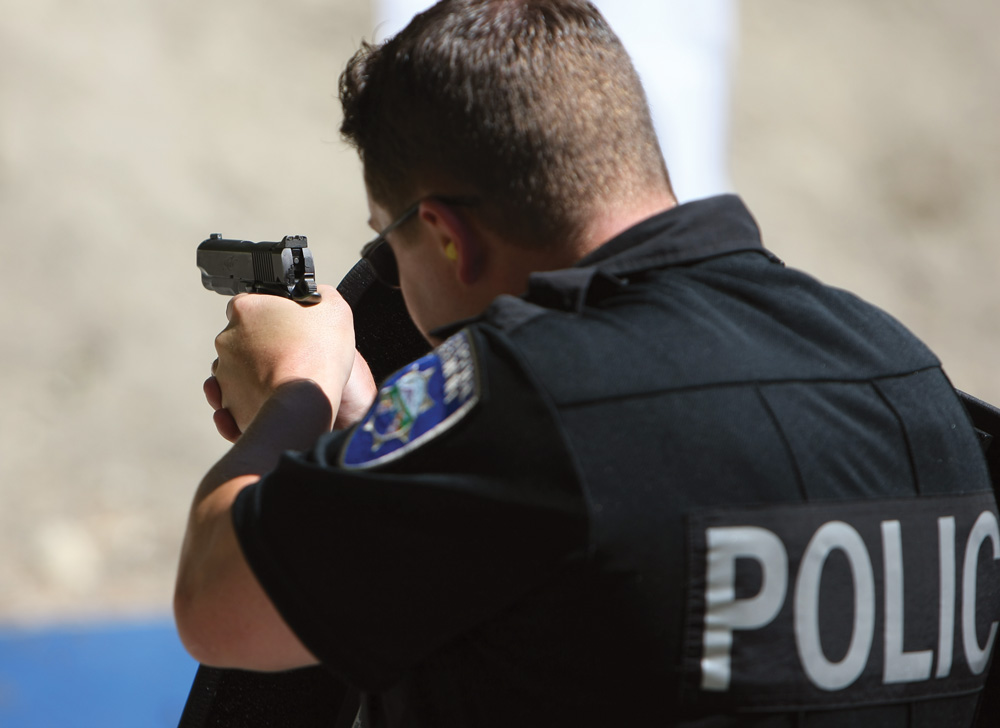
Moreover, the body of the offender may simply block the shooter’s view of the brother officer who is trying to apprehend or restrain the attacker from behind. In these situations, a “shoot-through” is highly likely to kill or cripple one of the Good Guys and Gals.
What does this have to do with private citizens’ use of CCW handguns? Only this: Where the cops jump in to protect their fellow officers, brave citizens may step in to protect their actual brothers and sisters, husbands and wives, sons and daughters, or fathers and mothers. Now it is your loved ones who are behind the offender — unseen by you — when you discharge your CCW weapon.
Those 115-grain jacketed ball 9mm rounds will pierce more than 2 feet of muscle tissue simulating ballistic gelatin. So will 230-grain full metal jacket 45 hardball.
By contrast, the depth of the average adult male thorax is probably no more than ten inches, from front of chest to back. Nor is it solid muscle: the spongy tissue and large air volume of the human lung offer little resistance to a bullet. It’s not just about New York City and 9mms.
In Arizona some years ago, a peace officer fired his 45 service automatic at a large male offender rushing him with a knife. He couldn’t see that a brother officer was running up behind the offender to grab and restrain him.
His gunfire dropped the offender…and passed through his body with enough force to deeply pierce the abdomen of the second cop, who had been trying to rescue the one who fired. That wounded officer almost died from those injuries, inflicted unintentionally by shoot-through with 230-grain full metal jacket 45 ACP. Call that incident Case Twenty-Five.
Many years ago in Los Angeles, an Aryan Brotherhood thug took several people hostage in an office. He demanded an escape vehicle and threatened to start shooting hostages if he didn’t get one. A vehicle was provided, and he got into the car with the victims.
At this point, the LAPD SWAT team launched smoke, and two members of the team whom I happened to know moved forward through the gray cloud, their issue Colt 45 automatics up and ready.
When the perpetrator reached for his pistol, the cops opened fire, using department-issue 230-grain hardball. They fired four shots between them, and killed the offender before he could launch a single bullet of his own.
Autopsy showed any of the four hits would have been quickly fatal. However, only one of those bullets stayed in the offender’s body. One of the three exiting slugs struck one of the hostages. Fortunately, the wound was not life-threatening. LAPD quickly switched to hollow points, which is what they use today. Lesson learned. Call it Case Twenty-Six.
Particularly in the small calibers, ball ammunition is infamous for its poor stopping power. When the Illinois State Police issued ball for their 9mm S&W pistols from 1967 through the early 1970s, their Ordnance Section told me, they never had a single one-shot stop on an armed felon unless he was hit in the brain or spinal cord.
This led the ISP on an odyssey in search of more effective ammo, which culminated in the famously effective “Illinois State Police load,” a 115-grain jacketed 9mm hollow point at +P+ pressure and 1,300 fps velocity. Today, Illinois troopers carry 180-grain high-tech hollow point in 40 S&W.
In Case Twenty-Seven, NYPD’s last high-profile shooting incident with 9mm ball ammo, four plainclothes officers engaged a young man named Amadou Diallo when he turned on them pulling an object that appeared, in the poor light, to be a small automatic pistol. All four opened fire, and five seconds later they had fired some 41 shots.
Nineteen of those bullets struck Diallo before he went down and dropped the object he was holding, which turned out to be a black nylon wallet. Sixteen of the 19 bullets over-penetrated. Diallo died of his wounds.
After a long and arduous trial, all four officers were acquitted. Had these officers been issued the department’s new 124-grain Speer Gold Dot +P hollow points in time, there is a good chance that he would have gone down with as little as one gunshot wound, giving Diallo a better chance of survival. No such horror stories have happened on NYPD since the hollowpoint ammo has been general issue.
When a bullet goes through a human body, it is not always possible to correctly determine entry from exit, particularly if the gunshot victim lives long enough for the healing process to begin.
Consider Case Twenty-Eight, in which the O.J. Simpson lawyers defending him against charges of murdering his wife and her young male acquaintance tried to impeach one of the state’s medical examiners by bringing up a previous case in which he had mistakenly diagnosed a through and through gunshot wound, confusing back-to-front and front-to-back.
In late 2007, I was involved in a murder case where it was alleged that the defendant had shot his opponent in the back of the neck, with the bullet exiting his face, implying that he was in no danger and therefore could not have acted in self-defense.
The weapon was a Beretta Model 96F pistol, and the bullet was a 180-grain round of full metal jacket UMC 40-caliber practice ammo. In fact, the bullet had entered the face of the attacking man, and coursed rearward and downward before exiting the neck. However, the assailant lived for a week before he succumbed.
During that time, he was lying supine in a hospital bed with his weight pressing the exit hole down against dressings and bed clothes as his body worked to heal the injury. This gave the wound a puckered appearance consistent with an entry wound.
At the same time, doctors and nurses were treating the open wound in the face, debriding it to prevent necrosis, so by the time he finally died, that wound had been cratered outward and mimicked an exit instead of an entry.
The medical examiner determined that entry was in the back and exit was in the front. Not until trial, did treating physicians familiar with gunshot wounds testify that when the “victim” came in, they diagnosed the wound as front entry/rear exit.
Defense experts concurred, and the jury acquitted, as they should have. But Case Twenty-Nine probably wouldn’t have gone to trial if the defendant had loaded his gun with proper hollow points, which almost certainly would have left the mushroomed bullet embedded inside the neck and shown that the attacker was shot from the front.
This article is an excerpt from the The Gun Digest Book of Concealed Carry 2nd Edition.
Precision shooting at close range is definitely more than a point-and-shoot affair. Understanding how your optic's offset (its distance off the bore line) affects shot placement will help you adjust your aim and place your shots where you want them. Adam Painchaud of the SIG-Sauer Academy explores how to holdover for offset in this NSSF video, giving you some solid tips and drills to stay on target no matter the distance.
Recommended Shooting Resources

It’s not easy to improve on a classic, and any change to an iconic product is bound to bring with it some level of criticism.
There certainly have been changes in Browning’s line of over/unders during the past 82 years, but the overall appearance and function of the guns has remained largely unchanged.

Sure, they’ve gone through a series of aesthetic and nomenclature changes—the Model 325 gave way to the 425, the 425 begat the 525, then the 625, and so forth. There were upgrades and tweaks along the way, both cosmetic and mechanical, but the formula remained much the same.
Then came the 725.
The 725 doesn’t represent a radical revolution in either form or function, and many shooters would have a hard time telling the current 725 apart from its varied predecessors.
Browning realized long ago that the Superposed/Citori line appealed to the purist, and it is unlikely we’ll see any dramatic changes or avant garde styling details on any new version of the company’s storied stack-barrel in the near future. But there are changes to this latest model, some of which are minor—and some of which are significant.
The most striking change can’t be seen while examining the smooth lines of the new 725. The most telling difference between it and all the Browning over/unders that came before lies within, specifically within the trigger assembly.
Browning has always relied on inertia triggers for its Citoris, which means the recoil energy generated by the first shot cocks the firing pin for the second barrel.
On the 725, the traditional inertia trigger has been replaced by a mechanical trigger, which does not rely on the first barrel firing to fire the second.
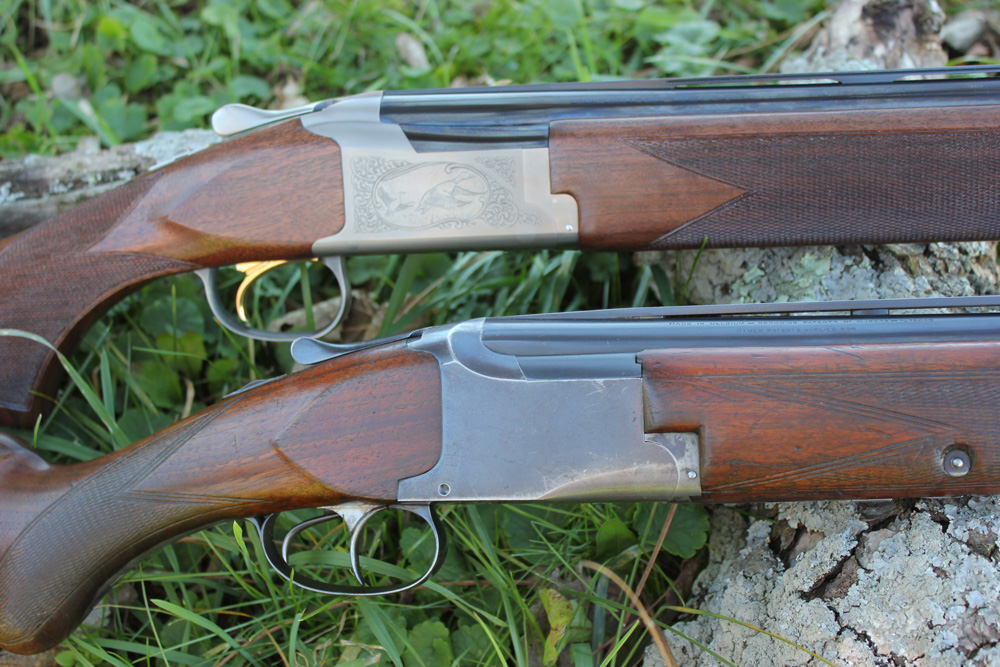
In addition, Browning incorporated its new FireLite trigger into the design of the 725. This is truly an evolutionary step forward for the Citori line. The quality of triggers in centerfire rifles has improved vastly over the last decade, but very few companies boast that they offer light, crisp, clean triggers in their shotguns.
The new FireLite system breaks at under four pounds, for both trigger pulls, without any creep, and the new Browning trigger is as good or better than anything short of high-end competition shotguns. It may go unnoticed by the casual shooter, but experienced shotgunners will appreciate the new trigger.
The other major alteration to the 725 has to do with the depth of the action. Since John Browning’s original Superposed version, Browning guns have had deep actions, due in part to large, full-length hinge pins.
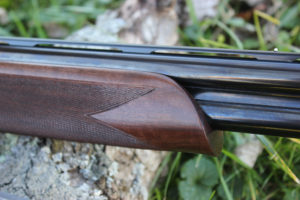
The design was robust and durable, but many shooters preferred the sleeker, thinner, Italian guns like those of Beretta and Fausti, with their low-profile boxlock actions.
The 725 was Browning’s first attempt to narrow the storied action, and even though the company shaved less than 3/16-inch from the vertical depth of the 725 by reducing the size of the hinge pin, it looks much sleeker.
The pistol grip contour has changed slightly, too, and is now canted rearward. The result is a gun that feels livelier and more connected to the shooter. The overall look of the gun is less paunchy than with previous models.
Other styling changes are far more subtle, but, to the Citori purist, these changes will immediately stand out. First, the action release lever on the top of the gun is radically different that the model that has been standard on Browning Citori guns since production began.
Citoris have traditionally had a more rounded knob on their top levers than other shotguns, but the new 725 has a longer knob that stretches farther along the tang and is vertically shorter than traditional lever knobs. It’s a minor detail, yes, but the Browning fans I shot with recognized it immediately.
Browning has never tried to make its Citori guns look gaudy or radical. You won’t find any faux-gold game birds on the action, and scrolling has been kept to an austere but classy minimum.
The new 725 Field bears traditional game scene engravings on each side of the receiver; a duck adorns the right side and a pheasant can be seen on the left. The engraving is very good quality. Likewise, the oil-finished grade II/III walnut stock is nicely figured, and the dark wood stands in sharp contrast to the silver nitride receiver.

As it is with its predecessors, the 725’s receiver is steel and not aluminum. The overall weight of my test gun with 28-inch barrels was 71/3 pounds.
The fore-end appears to be a hybridization of the style found on the company’s classic Lightning, and the schnabel style preferred by the sport shooting crowd. Regardless, the hands falls naturally in place and the grip is secure.

The Inflex recoil pad is the same version found on other Browning guns like the Maxus and does a fine job minimizing recoil.
When the 725 Citori that I was to test for this article arrived, I pieced it together and was immediately impressed by its sleek lines and obvious build quality.
The changes aren’t radical, but I will say that I believe that those in action contour were indeed needed and well executed on the new gun.
Even a 3/16-inch reduction in action depth brings the shooter’s hands noticeably closer to the center of the gun, and the overall feel and handling of the 725 is better than with previous models. It isn’t enough of a change to send purists into fits of rage, but it is effective and noticeable.
Browning guns are favorites in competitive skeet and sporting clays circles, and I believe the new 725 won’t miss a step in the competition world; though the version I tested was a field gun, the DNA is there for a quality competition gun.
The balance point is just ahead of the receiver, meaning the weight is evenly distributed between the hands.
The field gun wears white front and mid-beads and includes the company’s new Invector DS thin-walled choke tubes, which are designed to seal out gases and residue that gum up other tubes and make them difficult to remove after excessive shooting.
The 725 seemed to pattern consistently, which helps the shooter break more clays and drop more birds.
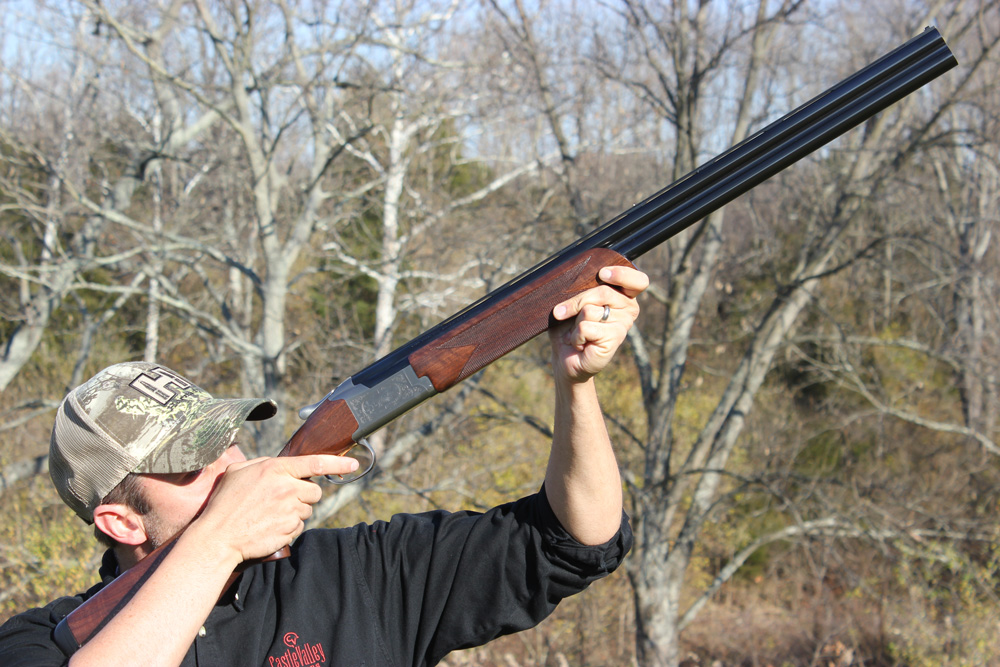
I took the Model 725 afield and spent a day hunting ringnecks in Ohio, and it performed as expected. I’d shot several rounds of trap with the gun not long before and found the gun to be responsive, easy to shoulder, swing, and shoot.
There was no difference when I hunted pheasants and, when a bird rose up in front of me, I shouldered the 725, swung the large white bead ahead of the rooster’s beak, and pressed the trigger as I passed the bird.
The trigger broke cleanly, and the pheasant cupped its wings, falling just ahead of the English setter hot in pursuit. Over the course of the day, I had a couple of more chances at birds, and the 725 worked its magic each time.
It’s always dangerous to mess with a successful recipe, but Browning made the wise decision to address the issues that hunters and shooters carped about, with regards to their world-beating over/under. The result is an even better Citori, which is saying a lot, because the previous version wasn’t too shabby.
Specifications
Browning 725 Citori Over/Under Shotgun
Caliber/Gauge: 12-gauge
Barrel length: 28 inches
Weight: 7.3 pounds
Overall length: 45¾ inches
Finish: Silver nitride receiver; blued barrels
Stock: Grade II/III oil-finish walnut
Triggers: Mechanical, 3.8 pounds
MSRP: $2,469.99
Contact: Browning www.browning.com
This article is an excerpt from the Gun Digest 2014 annual book.
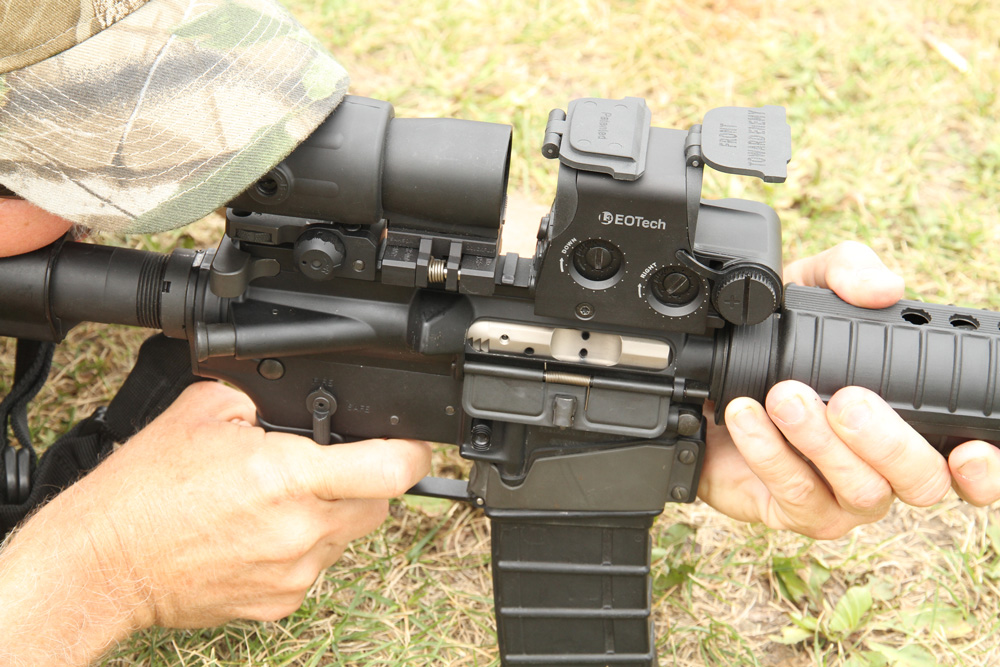

The red-dot sight began with the Aimpoint back in the very late 1980s. It appeared in the U.S. in competition at the 1990 USPSA Nationals, on the pistol used by Jerry Barnhart. The first reaction was, “No way will that work.” After Jerry cleaned everyone’s clocks, Doug Koenig had one on his pistol a few months later at the IPSC World Shoot, where he became world champion.
As soon as national-level 3-gun competition began, rifles had red-dots on them. They were derided as “impractical” and “not real combat gear.” In the beginning, yes. But the reliability imperative of practical shooting competition (your gear is your problem, once the clock starts, and if it fails you do not get a do-over) meant all competitors using them were always looking for more reliability, durability and utility.
By the second Iraq war, red-dot sights had been adopted and proved their usefulness. It was mildly amusing, seeing photos of M4s in Iraq, rifles that were equipped to have made decent but not match-winning Open class 3-gun rifles back in the 1990s.

Red-dot sights work by projecting a red dot, reticle or other pattern onto a screen inside of a tube or housing. The miracle of optical physics presents the dot to you as if it were on the same optical plane as the target.
That is, it appears to be “out there” and not a dot a few inches from your face. This means your eye has only the one focus job, dot and target together. Your brain has only two things to deal with, dot and target.
You place the dot on the target and press the trigger.
But wait, there’s more goodness: the dot is, essentially, parallax-free. That is, if the dot appears to be at the edge of the field of view, the bullet will still strike at the dot. Moving the dot does not change the agreement of dot with bullet.
The bad news is simple, most dots need batteries.
Magnifying optics were not new when they began to be adopted on rifles in the trenches in WWI.
Since then, they have increased in durability, light-gathering, clarity and reticle designs. What they do is let you see better, but not necessarily shoot better.
The choice of magnifying optics comes down to a matter of balance. That is, size and weight against increased magnification and fragility.
Increased performance increases cost, where a top-grade scope can cost more than the rifle it is mounted on. And with variable scopes, there is a need to shift from one power to another, as any extreme is useful only for a specific purpose.
A 3-9X scope is great, at 9X, if you are shooting at something at extreme range. Let a target of opportunity pop up ten yards away, and 9X is very much the wrong power to be on.
This is an excerpt from Gunsmithing the AR-15 Vol. II.
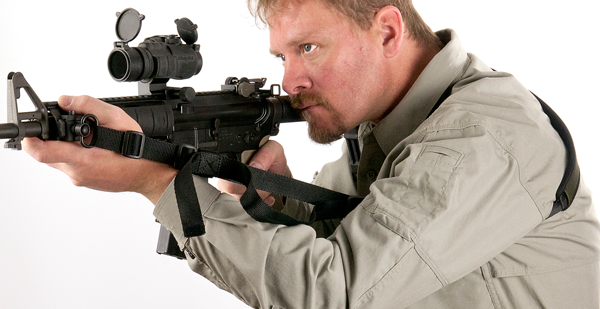
Vero Vellini slings have become a fixture from the African veldt to the flooded timber of Arkansas. Now, the German manufacturer has its sights set on a different shooting segment.
The company launched its Vero Tactical line at the 2014 SHOT Show and should get modern sporting rifle fans and tactical operators chattering with its newest sling. The Vero Tactical Two-Point Adjustable Sling will attempt to earn its share of admirers combining versatility and comfort in one package.
The sling is constructed with textile webbing for long-lasting durability and is outfitted with the company’s proprietary closed-cell padding. All the sling's components are synthetic, so inclement conditions have no effect on its performance and there is no possibility of corrosion over the long haul.
The Vero Tactical Two-Point Sling allows users to quickly, quietly and easily transition from a comfortable inverted-high-chest-carry position to any shooting position. By simply pulling out on the tethered-loop-release buckle the sling's tension is released and the firearm can be moved into position.
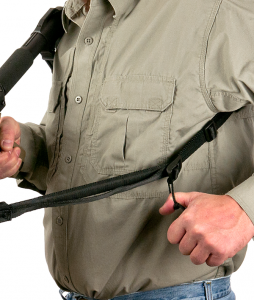
The Two-Point Sling can be attached on either end to a 1-inch or larger sling swivel, or it can be wrapped around a standard collapsible AR-style stock.
It allows more than 24 inches of adjustment, in turn a firearm can be worn over anything from a T-shirt to body armor plus several layers of clothing.
The Vero Tactical Two-Point Sling fits all platforms from the ultra-short AUG bullpup through the full-length AR-10 semi-automatic rifles, as well as many bolt-action rifles. A wrap-style sling keeper retains the excess webbing on shorter rifles.
The Vero Tactical Two-Point Sling will be available in March in either solid black or black with an olive-green padding cover. Suggested retail price of the Vero Tactical Two-Point Sling is $64.99.
Recommended AR Resources
Gun Digest Shooter's Guide to the AR-15
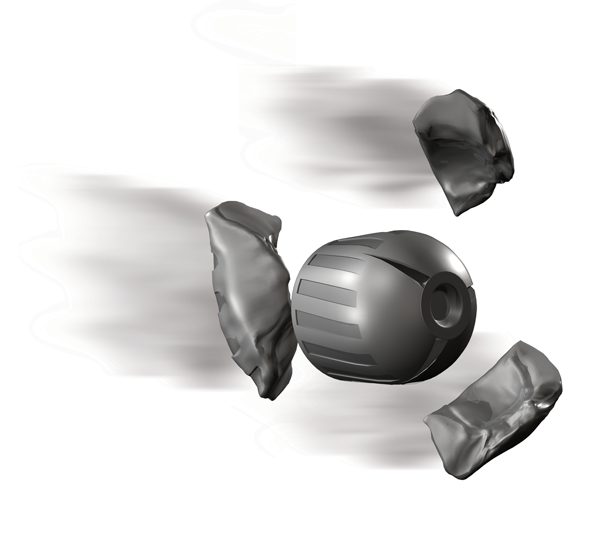
Winchester introduced the Defender line of personal defense ammunition five years ago, giving shooters a reliable option to protect themselves, their homes and their families. The company recently announced it's continuing to expand the line, now to include a shotgun gaining in personal defense popularity.
Winchester is releasing a 20-guage segmenting slug that gives shooters the advantages of slug and buckshot, while eliminating the need for two different rounds. The company's aim with the ammunition is to simplify the shotgun platform, allowing one round to be used for all situations.
Traditionally, cycling slug and buckshot rounds required plenty of practice on the part of those who shouldered a shotgun as a defensive weapon. Utilizing each round required the mastery of the tactical reload, as well as a system to quickly access and identify each round. The Defender segmenting slug attempts to avoid this with Winchester designing a round that acts like both a slug and buckshot.
The slug is a frangible round, breaking into three equal projectiles upon impact. The design of the slug gives it three distinct advantages over traditional solid rounds and buckshot, according to Winchester. It delivers more knockdown power than traditional buckshot loads, due to greater mass. It decreases aiming error, since the round fragments. And because the slug breaks up, it reduces the chance of pass through and stray projectiles.
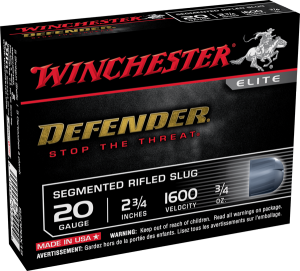
Winchester has offered Defender rounds in 12 gauge and 410, but is following market trends in expanding their line to 20 gauge. The 20 gauge is gaining popularity as a personal defense weapon, allowing shooters many of the tactical advantages of a 12 gauge, without as much felt recoil.
“It's our job to create the right product for every situation whether it's for hunting, recreational shooting sports or personal defense,” Brett Flaugher, Winchester Ammunition vice president of sales, marketing and strategy said. “The addition of the 20 gauge segmenting slug to the Defender line provides customers and responsible gun owners with more options to defend themselves when faced with life-threatening situations.”
Winchester Defender Segmenting Slug specifications:
Gauge: 20
Length of Shell: 2 3/4″
Slug Weight: ¾ oz.
Velocity: 1600 fps
Recommended Shotgun Resources
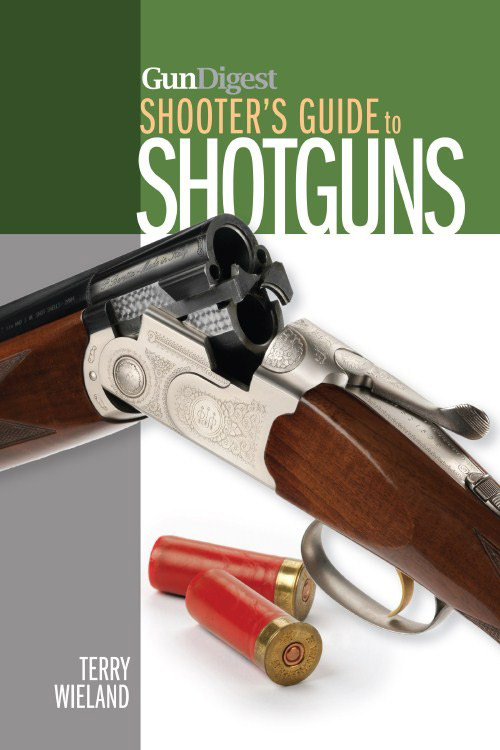 Gun Digest Shooter's Guide to Shotguns
Gun Digest Shooter's Guide to Shotguns
Gun Digest Book of Shotgunning
Gun Digest Book of the Remington 870
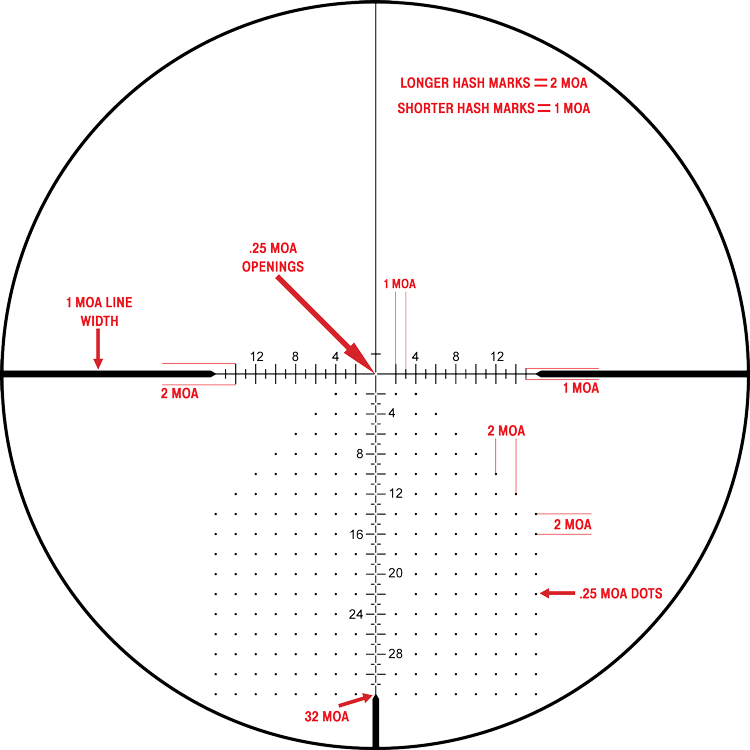
MOA-based reticles aren't new, but now Leupold is adding this option to its line of scopes with the introduction of the TS-32X1 reticle, a minute-of-angle (MOA) based system designed to allow for precision shots without the need for dial adjustments.
It features a heavy post and thin stadia crosshair with 1-MOA hashmarks on both the horizontal and vertical lines. Every other hash mark on the horizontal stadia is slightly longer, giving simple 2-MOA measurement reference. Every four MOA is indicated by a number.
The vertical stadia is also set up with 1-MOA tics and longer 2-MOA marks. In addition, every fourth mark is numbered, all the way to the complete 32-MOA elevation range. Wind dots in the lower half of the reticle are spaced in 2 MOA increments, both vertically and horizontally, very similar to the Horus Vision design that's become so popular.
This system allows for immediate and precise holdovers and wind holds as well as range estimation.
The TS-32X1 is the first in a family of MOA-based reticles that will cover several magnification ranges.
The bad news: As of the date of this writing, this new reticle is only available for most second (rear) focal plane VX-3, VX-III, Vari-X III and Mark 4 4.5-14 LR/T rifle scopes.
If you already own any of these models and want the TS-32X1 it can be retrofitted for $159.99 through the Leupold Custom Shop. To add the TS-32X1 to a new rifle scope ordered through the Custom Shop is $129.99.
The bad news is, my Mark 4 LR/T 10X40mm M3 will have to keep its Mil-based reticle awhile longer, which means I'll have to keep cranking on those 1-MOA turrets.
The good news is that the arrival of the TS-32X1 reticle means Leupold is listening to shooters. And they tell me the reticle will be available on additional models soon.
 It is with sad hearts that Gun Digest reports reliable sources close to the Cabela’s corporate offices are reporting that Dick Cabela, founder of the Cabela’s retail empire, passed away this morning at his home in Sidney, Neb. He was 77. There are currently few details available, but the company is expected to release a statement soon.
It is with sad hearts that Gun Digest reports reliable sources close to the Cabela’s corporate offices are reporting that Dick Cabela, founder of the Cabela’s retail empire, passed away this morning at his home in Sidney, Neb. He was 77. There are currently few details available, but the company is expected to release a statement soon.
The following account of the founding of Cabela’s is courtesy of the company’s website:
Cabela's, the World's Foremost Outfitter of hunting, fishing and outdoor gear, was born somewhat inadvertently in 1961 when Dick Cabela came up with a plan to sell fishing flies he purchased while at a furniture show in Chicago. Upon returning home to Chappell, Nebraska, Dick ran a classified ad in the Casper, Wyoming, newspaper reading: “12 hand-tied flies for $1.” It generated one response.
Undaunted, Dick formulated a new plan, rewriting the ad to read “FREE Introductory offer! 5 hand tied Flies….25c Postage….Handling” and placing it in national outdoor magazines. It didn't take long for the orders to begin arriving from sportsmen and women around the country.
In typical direct-mail style, each order was mailed out with a mimeographed catalog of outdoor items Dick and his wife, Mary, added to their product line. In the beginning, Dick and Mary ran the business from the kitchen table of their home in Chappell.
By 1964, continued success and growth demanded a bigger and better location. The operation was moved from their kitchen table to the basement of Dick and Jim's father's furniture store and then on to various buildings in Chappell. In 1969, Cabela's was operating in a 50,000 square-foot vacant John Deere building in neighboring downtown Sidney, Nebraska.
Click here for the complete Cabela’s history and Dick’s role in this industry-changing retailer.

Necessity continues to be the mother of invention. That especially goes for Empire State gun owners. There has been a rash of new gun accessories that have gone on the market in a bid to help New York gun enthusiast hit by the NY SAFE Act. The more Draconian aspects of the year-old legislation have to deal with modern sporting rifles and magazine capacity. On the magazine end of things, standard-capacity versions — 15- and 30-round magazines many firearms leave the factory with — are now verboten. As for rifles, the state has expanded the list of what constitutes an “assault weapon”. In turn, most factory stocked modern sporting rifles are now illegal to sell or buy. And ones that existed before the SAFE Act must be registered with the state police. That’s where many of the newly minted accessories have come into play. And for the time being, some modifications appear to meet the standards set by the SAFE Act. As reported at the TimesUnion.com (out of Albany, N.Y.):
Prototypes for the new rifles have been on display at gun shops from western New York to the Adirondacks in recent weeks. And now a lawyer representing one shop says he has gotten what amounts to an OK from the state, in the form of a letter from a State Police lawyer confirming that AR-15-style guns should be legal as long as they lack the characteristics prohibited by the law.
What follows is a look at a few of the tweaks that have been made in an effort to keep New Yorkers behind the trigger.

It was similar to the any dozen of toy guns my friends and I played with when I was a kid in the 70s and 80s. My son had a new friend from school coming over that day, and he commented that he wanted to show him his guns.
“That’ll be fun,” I said, but then a thought hit me.
As a kid before video games and “play dates” became the norm, my life and those of my friends revolved around Whiffle ball, bikes and playing guns—sometimes as cops and robbers, sometimes as cowboys and Indians. More often than not, however, in a time when WWII victories were glorified in the movies and young men were returning from Vietnam with tales of battle, playing guns took the form of mimicking war.
But these are different times, and given the modern suburban disconnect from hunting and firearms common to many of our fellow citizens, I know quite a few parents who don’t allow their kids to play with toy guns. For that reason, I suggested to my boy that he put the guns up; at least until I could talk to the other parents and see how they felt about the matter. I didn’t want to make decisions for their kids anymore than I want them making them for mine.
But this concern isn’t just relegated to non-gunowning parents. I know of at least one gunowner, who in the interest of teaching his children gun safety, doesn’t allow them to play with toy guns either.
My question to you then, as gunowners and parents teaching our kids to respect firearms, should children today be allowed to play with toy guns?
When we posed this question to our magazine readers, the response was spirited to say the least, and while most of them were more than fine with allowing their kids or grandkids to play with toy guns, there were quite a few different opinions as to what type of play was acceptable. Many of these initial responses will appear in the March 27 issue of Gun Digest. Check it out if you get a chance.
In case you missed the opportunity to comment before, we’d love to know how you feel on the topic. Let us know your thoughts and we may just share them in another future issue of Gun Digest as this is quite clearly a topic where most folks have an opinion.
Simply comment below, email us at [email protected] or join the discussion on our Facebook page. We'd love to have you be a part of our Gun Digest community.
Recommended Resource
Are you looking for a guide to provide your children with an understanding and respect for firearms? Gun Safety in the Home is your resource. Written by renown firearms instructor Massad Ayoob, the book teaches fundamental firearms safety principles, proper firearms security and storage methods and the correct way to handle firearms, among other important concepts.